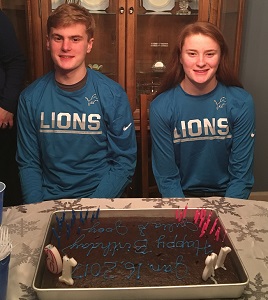
Like Parents, Ayrault Twins 'Born to Play'
By
Tom Markowski
Special for Second Half
November 30, 2017
GROSSE POINTE WOODS – Kim Ayrault and her husband Andy were careful not to overly encourage their children to play sports, specifically basketball, the sport they played so well for so long.
 But if their children did decide to play, they would teach them to play the right way and be there every step of the way.
But if their children did decide to play, they would teach them to play the right way and be there every step of the way.
Julia and Joe Ayrault, juniors at Grosse Pointe North, are the first set of twins born to Kim and Andy. Annabel and Adam are the second. Born nearly four years apart, all four play basketball and the younger pair play multiple sports.
The Ayraults are a family whose lives often revolve around practices and games, and driving to and from said events. It can be simultaneously rewarding and tiresome, and they wouldn’t have it any other way.
Kim recalls one of her first memories of Julia, a 4-year-old bouncing up and down the court.
“She went to the basket and scored,” Kim said. “Then she came back down with her ponytails flying and waving her hands up in the air, and I said to myself, no, no, no. I went up to her and said, you can’t do that. You can’t celebrate like that. She learned. She never did that again.
“She was competitive at that age. She was born ready to play.”
Julia Ayrault started bouncing a basketball just about the time she learned to walk. When her parents introduced her to the sport, she dove in head first and hasn’t looked back.
She tried soccer. That didn’t last. As a second sport she preferred baseball, but basketball was always first.
Julia and Joe, 16, both play varsity basketball and anticipate having more than just a good season. Their parents were also fine basketball players in the Pointes, Kim at North, Andy at Grosse Pointe South. The Ayraults’ other set of twins also play basketball, at Grosse Pointe Shores Our Lady Star of the Sea. Annabel and Adam are in the seventh grade and, yes, they’re good players, too. Annabel plays volleyball as well and Adam plays baseball. He was a member of the Grosse Pointe Shores/Woods Little League team that reach the World Series in Williamsport, Pa., this past summer.
After graduating from high school, the Ayraults began dating while playing basketball at Wayne State University. Andy was a junior, Kim (Reiter) a sophomore. Both had fine careers, both played four years and Andy went on to have a brief career professionally in Europe. The two are tall: Andy is 6-foot-7 and Kim is 6-foot, and, not surprisingly, their children are tall. Julia is 6-2, Joe 6-5.
 It’s too early to tell, but Julia just might be the best. A three-year starter for longtime coach Gary Bennett, she has committed to Michigan State and is one of the state’s top players in the class of 2019. Bennett coached Kim in high school, and he first saw Julia play when she was in elementary school.
It’s too early to tell, but Julia just might be the best. A three-year starter for longtime coach Gary Bennett, she has committed to Michigan State and is one of the state’s top players in the class of 2019. Bennett coached Kim in high school, and he first saw Julia play when she was in elementary school.
Andy has coached Julia, on and off but mostly on, since she started playing. Currently Andy is Bennett’s assistant coach. Andy also coached Julia at Star of the Sea and began coaching his two eldest children when they were in elementary school.
“From third to sixth grades I had her playing on the boys AAU team,” Andy said. “I used to put them on the same team because she was so good. In the seventh grade we switched out of AAU to the CYO (Catholic Youth Organization). Going on a weekend and playing four AAU games in one day wasn’t doing her any good. Playing two CYO games and practicing three days a week was better.
“Joe should have a breakout season. Julia had a breakout summer. She played more on the perimeter. She’s athletic enough to cover the post and take the ball to the rim.”
Andy has never stopped working with Julia, even if he wasn’t officially her coach. She developed a love for the game at an early age and Andy continued to teach, lending support as Julia’s game continued to improve.
“She blows our mind all the time,” Kim said. “We’ll say to each other later, did she really do that? When I watch, I see it from the stands and it’s a different look than what Andy sees. I’ll yell something at her during the game. Andy doesn’t like me doing that. I still do it.”
In addition to her playing basketball with the boys for three years, the athletically gifted Julia also played outfield and was a pitcher on a little league baseball team with her brother for two years. Also teaming up with Julia on that little league team was Evelyn Zacharias, one of Julia’s best friends and now a member of the North varsity basketball team as well.
One of Julia’s first memories of playing sports is a positive one.
“I remember when I was at Star of the Sea, we went a long way (in the playoffs),” she said. “It started to be a lot of fun. A lot of those girls who were on that team are at North with me. Evelyn and others. We have the memories.”
Kim and Andy have memories, too, and there are many more to come.
Right now, their lives are often discombobulated trying to give the four equal time. It’s a great goal in theory, but much more difficult to accomplish in reality.
 A typical day will find Kim driving home after work as an elementary school teacher to pick up Julia from practice and get Adam to his game at Star of the Sea on time. One particular evening the MSU women’s team is playing the University of Detroit at Calihan Hall and Kim and Julia are going. Home by 10 p.m., there’s time for a snack before the good nights are said.
A typical day will find Kim driving home after work as an elementary school teacher to pick up Julia from practice and get Adam to his game at Star of the Sea on time. One particular evening the MSU women’s team is playing the University of Detroit at Calihan Hall and Kim and Julia are going. Home by 10 p.m., there’s time for a snack before the good nights are said.
“People, many of our friends, tease us that we make them do this,” Kim said. “We’ve never done that.”
Kim keeps a schedule of all the comings and goings on a board hanging in the back of the house. She does it alone. She doesn’t trust anyone else to keep track.
Andy is in between jobs so his free time, if you can call it that, consists of completing Kim’s honey-do list.
“We were laughing the other day,” Kim said. “How did we do this before when (Andy) was working? I’m just trying to be patient.”
At the very least, 20 years of marriage will teach you that.
In addition to his work with Julia, Andy coaches Adam’s team at Star of the Sea, and he’s usually the one taking Julia and Joe on trips, whether it be sports-related or the occasional trip to check out a college campus.
Julia said with every member of the family involved in sports in one capacity or another, it helps keep them all together, at the dinner table, riding in a car or wherever.
“(Sports) is a big topic all of the time,” she said. “We have fun with it. We mess with each other.
“My dad has taught me a lot about the game. The biggest thing is to put others before yourself. My biggest thing is to get my teammates involved. Even if they’re not going to play in college, it should be a good experience for them. I try to make sure everyone has their role. I don’t want it to be about me.”
 Tom Markowski is a columnist and directs website coverage for the State Champs! Sports Network. He previously covered primarily high school sports for the The Detroit News from 1984-2014, focusing on the Detroit area and contributing to statewide coverage of football and basketball. Contact him at [email protected] with story ideas for Oakland, Macomb and Wayne counties.
Tom Markowski is a columnist and directs website coverage for the State Champs! Sports Network. He previously covered primarily high school sports for the The Detroit News from 1984-2014, focusing on the Detroit area and contributing to statewide coverage of football and basketball. Contact him at [email protected] with story ideas for Oakland, Macomb and Wayne counties.
PHOTOS: (Top) The Ayrault family, from left: Annabel, Adam, Andy, Kim, Julia and Joe; inset: Julia and Joe suiting up for Grosse Pointe North. (Middle) Julia and Joe celebrate a birthday together in 2012. (Below) Julia and her dad/assistant coach Andy anchor the right side of the team photo after last season’s District title win. (Photos courtesy of the Ayrault family.)

Soccer, Hoops Next to Seed Using MPR
August 6, 2019
By Rob Kaminski
MHSAA benchmarks editor
As the topic of seeding for MHSAA Tournaments continues to swirl in the air of numerous committee meetings on an annual basis, one of the primary concerns continues to focus on the simple question: “How?”
The MHSAA for years has been working behind the scenes on potential formulas which could best be used as a standardized tool to assist in measuring strengths of teams in a given sport.
This spring, the MHSAA introduced the Michigan Power Rating in the sport of Boys Lacrosse. The Representative Council approved limited seeding beginning in 2019-20 for girls and boys soccer and girls and boys basketball, and MPR will be the metric to determine which two teams must be seeded on opposite sides of District brackets in those sports.
“The boys lacrosse tournament has been seeded since it was added as an MHSAA-sponsored sport in 2005. The seeding is done by committee based on several criteria, one of which was statewide power rankings generated by a third-party website. In the Fall of 2018, that website ceased operation – it was the perfect opportunity for the MHSAA to develop its own data-driven, purely objective ratings system and incorporate that data into the seeding criteria,” said Cole Malatinsky, administrative assistant for the sport.
“The benefits of the new MPR system have been already mentioned – it is MHSAA controlled, simple, objective, and transparent, and it can be used by other MHSAA sports in the future.”
MPR is a computer rating formula similar to the popular RPI rating. MPR provides a way to measure a team’s strength relative to other teams, based on games played against other MHSAA tournament teams, largely on the strength of their opponents’ schedules. MPR is purely objective using only the game results listed on MHSAA.com – there is no subjective human element.
What is the basic MPR formula?
MPR is calculated using wins, losses and ties for games played between teams entered into the MHSAA tournament. The final MPR number is 25% of the team's winning percentage, plus 50% of its opponent's winning percentage, plus 25% of its opponent's opponent's winning percentage.
MPR = (.25 x W%) + (.50 x OW%) + (.25 x OOW%)
The MPR formula can be applied easily to other MHSAA team sports.
What game data is included in the formula? What game data is not?
MPR looks only at results between opponents entered into the MHSAA postseason tournament. Wins, losses and ties in multi-team shortened game tournaments (lacrosse, soccer) also count. Forfeits also are counted as wins and losses.
MPR does not use the specific scores of a game or the margin of victory in a game. The location of a game is not included in the MPR formula, and the formula weighs results at the beginning of the season the same as results at the end of the season. Scrimmages are not included.
Why use the MPR formula?
Different rating systems have been used in the past or have been recommended to the MHSAA. We wanted to have a rating system where the data was controlled and stored in house and could be used for any sport featuring head-to-head competitions.
With its own rating system the MHSAA also can control the different components of the formula, thus keeping the tenets of scholastic competition at the forefront (like not including margin of victory in the formula). Finally, by listing all scores and team schedules online, as well as showing the MPR calculator on each team schedule page, the ratings are transparent and can be replicated easily.
CALCULATING MPR
What are the detailed components of the MPR formula?
You need three numbers to calculate your MPR: winning percentage (W%), opponent’s winning percentage (OW%) and opponent’s opponent’s winning percentage (OOW%).
How do you calculate winning percentage (W%)?
Divide the number of wins by the number of total games played. A tie is worth half a win. For MPR purposes, find the winning percentage against all teams that will play in the MHSAA tournament (MPR W%). Games played against out-of-state teams, varsity “B” teams, junior varsity teams, non-school club teams, and any other non-MHSAA tournament participants should not be included when calculating winning percentage. W% should be an easy number to calculate.
How do you calculate opponent’s winning percentage (OW%)?
Average the winning percentages of a team's opponents. When calculating the winning percentage of a specific opponent, use the opponents "Adjusted Winning Percentage" (ADJ W%). Adjusted winning percentage eliminates all games the team played against that opponent (as well as its games against non-MHSAA opponents).
For instance, if the team beat an opponent with an overall record of 4-1, use a record of 4-0 (1.000) for that opponent. If the team lost to an opponent, use a record of 3-1 (.750). Find the ADJ W% for all opponents, and then take the average. If a team plays an opponent team twice, that opponent’s ADJ W% will be counted twice.
OW% is not calculated via the combined record of the opponents; instead take the average of all opponent’s winning percentages.
How do you calculate opponent’s opponent’s winning percentage (OOW%)?
Use the same process described above, except calculated for the opponents of a team's opponents. This number is much harder to manually calculate, so the OW% for every team is listed on the MPR page of the MHSAA website.
Again, simply take the average of all opponent’s OW%.
How often is MPR calculated?
MPR is calculated about every five minutes. Enter a score and a minutes later the team MPR and the MPR of all the team's opponents will update.
How much will my MPR change throughout the season?
You will see wild MPR swings in the beginning of the season, but after about 10 games played your MPR will start to level out. At 20 games played you will see very little movement with each additional game played.
My score is missing. How can it be added?
This is a crowd-sourced system. Any registered user of MHSAA.com can add a missing score. ADs, coaches, parents, students and fans all can login and enter a score for any game.
What are some common errors when calculating MPR?
When calculating your team’s winning percentage, only include games against MHSAA-tournament teams. When calculating your opponent’s winning percentage, don’t include the games they played against you. When calculating ties, count the game as a half-win and half-loss.
What happens if a game is cancelled?
Because the MPR system works off of averages, it will not make a difference in the final MPR if a game cannot be rescheduled. It would not penalize, nor benefit, any team involved in that scenario.
USING THE WEBSITE
Where can I find game scores?
A list of statewide scores for all sports can be found in the MHSAA Score Center. To find a schedule for any team click on “Schools & Schedules” in the top navigation bar, search for the school, then once on the school page click the sport. You can also see a list of all schools (with links to schedules), on the statewide MPR list.
“We continue to have great success in score reporting for varsity boys lacrosse contests. While we state that schedule submission and score reporting to MHSAA.com are required, athletic directors and coaches understand that in order for MPR data to be accurate, we need consistent and accurate score reporting,” said Malatinsky. “MHSAA.com is now the primary site for high school boys lacrosse schedules, results and ratings in the state.”
How should I use the statewide list of teams and MPR?
Linked to the boys soccer page (and eventually to be added for both basketball pages and girls soccer) is a statewide listing of all Michigan Power Ratings (MPR) for teams entered into the MHSAA postseason tournament for that sport. Linked on the MPR page is an explanation of the District draw formula, describing when and how teams will be placed on the bracket.
The MPR data updates every five minutes. Click on the column headings to sort the data. You also can use the drop-down menu to show teams in one Division, or type a District number in the box to filter teams for that District (Region for boys lacrosse).
You also can click on any school name to go to its schedule page.
How do I read the school schedule page?
The schedule at the top of the page shows the date and opponent for all scheduled games, and results for games already played. If results are missing, click “Submit Score” to add a game score.
Below the game schedule is the MPR Calculator. The calculator is split into three sections. The first section shows the three MPR component scores for the team, as well as the team’s current MPR score. The second section shows the MPR information for the team’s opponents – specifically, for the opponents the team already has played (actually, for games where scores have been submitted). Only these games are included in the MPR calculation.
The third section highlights future opponents. The MPR data for future opponents are not used in the MPR calculation for the team.
PHOTO: East Kentwood and Ann Arbor Skyline play for last season’s Division 1 boys soccer championship.

